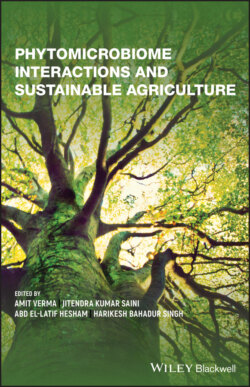Читать книгу Phytomicrobiome Interactions and Sustainable Agriculture - Группа авторов - Страница 32
3.2 Metagenomics
ОглавлениеFindings have revealed that a gram of soil contains 109 microbial cells. This exhibits a great diversity level by attaining about 106 taxa. Despite such diversity and number, only 1% of microbes residing in bulk soil and about 10% from plant‐influenced zones can culture in standard laboratory conditions. The majority of the soil microbiome remain uncultured. However, they can be detected using advanced molecular‐based approaches, which are discussed in later sections (Barret et al. 2013). Metagenomics allows the detection of microbial diversity in environmental samples and enables the construction of community‐level gene catalogs (Zengler and Palsson 2012; Franzosa et al. 2015; Guo et al. 2015; Widder et al. 2016). Broadly, metagenomics represents a new advanced approach for genomic analysis. It refers to the simultaneous characterization of genomes in microbial communities from environmental samples, using molecular techniques like PCR, cloning, and DNA sequencing for identifying new sources of plant growth–promoting traits. The approach of metagenomics has also been referred to as environmental genomics, ecogenomics, and community genomics (Song et al. 2013).
Through metagenomics, genomes of organisms in the community can be pooled by entailing the extraction of DNA from the community (Figure 3.1).
Usually, metagenomic analysis conducts 16S rRNA or 18 S rRNA gene surveys to observe microbial community composition while also informing the sequencing complexity required to access high levels of metagenome coverage (Tyson et al. 2004; Lauro et al. 2011). Complete sequencing of clones containing phylogenetic anchors can be performed by using sequence‐based metagenomics to indicate the taxonomic group. However, functional metagenomics has identified antibiotics (Hover et al. 2018; Wrighton 2018), antibiotic resistance genes (De Castro et al. 2014; López‐Pérez and Mirete 2014), degradative enzymes (Silva et al. 2013; Choi et al. 2018), and plant growth‐promoting traits (Tsurumaru et al. 2015). The clones containing metagenomic DNA can also be screened for expression activities by functional analysis. Although it holds great potential in terms of shaping ecological theory; however, due to the slow screening technology it is subsequently lagging behind shotgun sequencing (Zhou et al. 2015).
